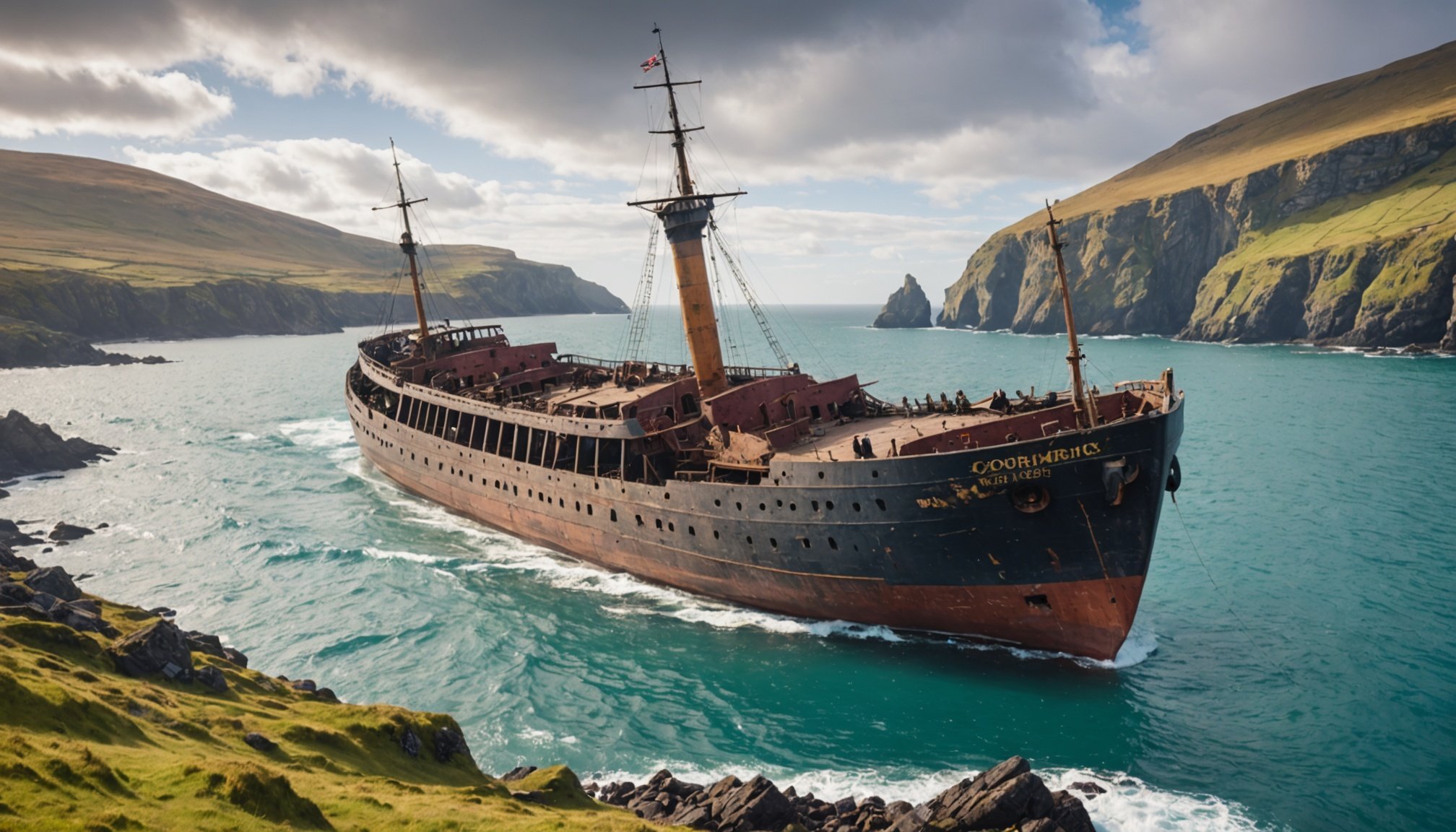Overview of Historic Shipwrecks in the UK
The UK’s maritime history is hugely enriched by numerous historic shipwrecks that dot its coastlines. These wrecks hold a trove of stories, offering insights into the past and the evolution of seafaring. Shipwrecks not only illustrate the technological advancements and naval battles of their eras but also reveal economic and cultural exchanges that shaped the nation.
Prominent famous wrecks include the Titanic, the SS Great Britain, and the HMS Victory, each with its own compelling tale. For instance, the legendary Titanic, though not a British ship, has a deep connection to the UK as it sailed from Southampton. It stands as a sombre reminder of the arrogance towards nature and the subsequent maritime regulations that aim to prevent such tragedies.
Also read : Explore UK Cruises Offering Exclusive Birdwatching Tours in Coastal Nature Reserves
Exploration of historic shipwrecks has tapped into the UK’s tourism industry, drawing enthusiasts and scholars alike to witness these underwater time capsules. Educational programs often use these wrecks to engage audiences in maritime history, sparking interest in both young and old.
By exploring these remarkable sites, visitors can connect with the events that once made headlines. Shipwreck exploration thus plays a pivotal role in conserving history, educating the public, and boosting the local economy through tourism.
Also to read : Explore Unforgettable UK Cruises: Your Ultimate Guide to Experiencing Iconic British Festivals and Traditions
Notable Shipwreck Sites and Their History
Understanding the importance of historic shipwreck sites enriches our appreciation of maritime landmarks. The Titanic, resting at the bottom of the North Atlantic, remains a symbol of tragic overconfidence, yet it has inspired rigorous preservation and archaeological efforts. Exploration of the site continues to uncover new artefacts, further deepening our understanding of this iconic disaster and improving general maritime safety.
Moving back in time, the Mary Rose serves as a testament to the Tudor Navy’s might. Raised from the sea in a remarkable salvage operation, this maritime landmark offers a window into 16th-century naval life. Its preservation ensures that visitors can experience a tangible connection to Britain’s naval heritage. The ongoing exhibition showcases the ship’s artefacts, providing an immersive educational experience.
In contrast, the HMS Victory is famed for its role in the Battle of Trafalgar. Though residing primarily above the waves, this shipwreck site signifies progress in naval strategies and technology. Actively maintained, it serves as a key educational site with extensive tour options. These shipwreck landmarks are crucial for learning about our past, highlighting the importance of historical preservation and offering a wealth of stories for visitors to explore.
Planning Your Cruise Adventure
Embarking on a cruise that showcases UK cruises with iconic shipwreck tours can promise not just a scenic voyage but an educational journey deep into the UK’s maritime history. Whether it’s insight into the tragic tale of the Titanic or exploring the technological marvels of ships like the SS Great Britain, each cruise offers unique encounters with these historic shipwrecks.
Recommended cruise itineraries often feature stops at prominent maritime landmarks, allowing passengers an intimate glimpse into the past. Imagine sailing along the routes once navigated by history’s most famous ships, each path narrating stories of old. The enchantment lies in living these tales firsthand, stepping into a world where history meets the present.
For those interested in specific adventure opportunities, it’s wise to choose cruises that include detailed shipwreck tours. These tours not only showcase the wreckage but also provide historical context, giving new perspectives to time-worn stories. When booking, consider cruise operators renowned for their knowledgeable guides and comprehensive exploration activities. This ensures a rich and memorable experience.
Lastly, ensure to pack appropriately and book your cruise itineraries well in advance to secure the best spots and tailor the journey to your interests, making your trip aboard truly unforgettable.
Adventure and Exploration Activities
For those drawn to maritime history, engaging in adventure opportunities at historic wreck sites offers thrilling insights. A key activity is scuba diving, an exhilarating way to explore submerged ships firsthand. Dive into the vessels that once braved the seas, witnessing marine life thriving around these eerie tales frozen in time. Experienced dive guides provide necessary safety tips, ensuring a secure and enriching experience.
But not all shipwreck explorations require getting wet. Guided tours are perfect for history enthusiasts who prefer staying dry while absorbing the rich history of these sites. Participants can expect in-depth narratives that bring these underwater stories to the surface. Tours are tailored to accommodate various interests, whether focusing on maritime strategy or cultural exchanges of bygone days.
Another captivating option is participating in historical reenactments and events. Become part of the action as actors portray pivotal moments from maritime history. These dramatizations are not only educational but immersive, allowing visitors to experience history’s pulse.
Adventure seekers will find a blend of exploration activities and learning in these experiences. Talented guides and trainers ensure that each exploration is both safe and memorable. Embark on a journey where history and adventure meet beneath the waves.
Unique Experiences and Cultural Perspectives
Delving into cultural heritage at shipwreck sites provides an enriching experience. Each wreck carries maritime folklore, weaving intricate tales of the past. These stories often highlight the courage and tragedy associated with maritime adventures, sparking the imagination of all who visit. For instance, the legend surrounding the HMS Victory’s role at the Battle of Trafalgar immerses visitors in naval strategy and heroism.
Shipwreck sites strongly contribute to local culture and identity, becoming cornerstones of community heritage. Coastal towns near these historic locations often host festivals and exhibitions that celebrate their maritime past. These events provide visitors with unique insights into how history has shaped local traditions and values.
The opportunities for immersive experiences are abundant. Many sites offer interactive tours where visitors can explore recreated ship interiors or participate in hands-on activities simulating historical seafaring techniques. Such engagements allow visitors to truly feel the era’s maritime pulse, creating a lasting connection to history.
To appreciate maritime folklore fully, consider participating in storytelling sessions offered at select sites. These sessions not only entertain but also preserve the oral histories passed down through generations, enriching the overall cultural experience.
Safety and Environmental Considerations
When exploring historic shipwrecks, safety is paramount. Safety tips such as ensuring you’re equipped with the right gear and taking weather conditions into account are crucial for a secure adventure. Whether you’re diving into the depths or embarking on a guided tour, prepare adequately to ensure a seamless experience.
Environmental protection is equally vital. Shipwrecks serve as sensitive ecosystems teeming with marine life. Tourism can affect these environments, hence responsible tourism practices are encouraged. Opt for tours that prioritise minimal environmental impact and educate visitors on the importance of conserving maritime habitats.
Adhering to regulations for divers and tourists ensures that these precious sites remain intact for future generations. Authorities often impose guidelines to protect both the wreck sites and their delicate surroundings. Understanding and following these rules not only aids in conservation but enhances your entire exploration experience.
Best Practices:
- Follow local guidelines
- Use environmentally friendly equipment
- Avoid disturbing artefacts and marine life
Such practices safeguard both the fascinating remnants of UK maritime history and the living organisms that now inhabit these structures. Embrace a mindset of preservation and respect while diving into these underwater treasures.










